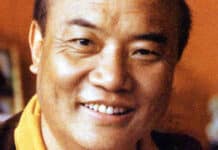Study Notes
by Carolyn Gimian
(Please Note: This is Chapter Twelve in the book Journey without Goal.)
Body of talk: 43 min. Questions: 21 min. Overall: 65 min. Date: August 9, 1974
Introduction: An astounding talk about the nature of siddhi and the four yogas of Mahamudra, which are described as four levels of magic in the Vajrayana.
Ground
The Sanskrit word for magic is siddhi, which means actualizing or working with the energy that exists in the realm of experience and of physical being.
| This is in contrast to Western notions of magic that are associated with mysteriousness and acquiring impossible powers. Reading comic books is subconscious feedback from our childhood that magic is something extraordinary. | ||
| One of the problems with this view is that it causes us to view the universe as a nuisance that we must overcome. Another problem is misunderstanding the role of ego and thinking that magic is about ego achieving enormous power. | ||
| In genuine mystical traditions, whether from the Christian, Jewish, or Buddhist traditions, mysteriousness has nothing to do with real magic. | ||
| To overcome these mistaken views, we need to start at the beginning and give up the idea of sudden enlightenment. We need to progress slowly and deliberately along the path. Then we discover that there is a genuine, magical aspect of the world. The greatest magic of all is to be able to control and work with our ego and with our mind. | ||
| As far as tantra is concerned, magic is working with the real world on a completely ordinary level. Magic is completely relevant to our world, our life and our path. |
Path
To discover magic, we have to go beyond the normal boundaries we establish for ourselves. We have to step over the threshold of samsara, beyond what seems reasonable. We have to give up our heart and brain. Beyond that, we discover the four levels of magic.
| The Tibetan Book of the Dead describes the brilliance we encounter in the bardo, which seems too bright, and we shy away from it. If we do this, then a soft, gentle light appears and when we go towards it, we find ourselves back in samsara. | ||
| We have to step beyond the boundaries, which sometimes feels as though we are going beyond basic sanity. We feel that we have given up so much, but there is more to give. We have no idea how to give our heart and brain, but we can do so and when we do, the real magic begins. | ||
| The first level of magic is one-pointedness. This is not like the one-pointedness of Hinayana meditation practice. That is like using a very sharp needle to sew our cloth together. One-pointedness at this level is like using a very dull, blunt stone needle that crushes the obstacles, very directly. Emotions are dealt with very directly, in their own place. There is no politeness. | ||
| The second level is simplicity or noncomplication. We no longer have to exaggerate ourselves or use any form of spiritual materialism to build ourselves up. This kind of simplicity is not romantic or simplistic. It is quite direct. It is self-existence: fire burns by its own simplicity but still has its own energy. A rock is magic because it just sits there without getting bored. | ||
| The third level of magic is one taste. Because of self-existing simplicity, things do not need any reference point. One taste is a one-shot deal. When students say that they feel pain and frustration for no apparent reason, there is some magic in that. They feel the nowness of the pain—or of the pleasure—as it is, personally and directly. | ||
| The fourth level of magic is nonmeditation. Here, meditation is contemplating an object or visualizing something and identifying with it. Nonmeditation means not meditating on anything. It is beyond the reference point of subject and object, providing a contrast to our normal sense of wanting so much. Magic here is an expression of nongrasping and nonaggression. It is also an expression of total energy and power. |
Fruition
We might wonder what is so magical about this. But we haven’t experienced these four levels of magic personally and we have no idea how powerful they are. The great Indian pandit Naropa said that practicing tantra is like trying to ride a burning razor. Maybe he was right.
The questions are an essential part of this talk and they contain the punchline of the whole discussion. Questions asked by the audience:
| In the biographies of the mahasiddhas, all kinds of magic happens, such as stopping the sun. What does this mean in light of our discussion here? | ||
| You talked about approaching the threshold that you have to step over. Where does the inspiration come from to step over this threshold? | ||
| Can you enter into these threshold situations volitionally? | ||
| Would the moment of breaking through the threshold be a moment of inquiry or of humility? | ||
| Would you share an example of how you have used magic to change your karma? | ||
| A lot of energy goes into constantly wanting, as you mentioned. What happens to the energy in the state of nonmeditation? | ||
| If nonmeditation is magic, what is meditation in relationship to that? |







